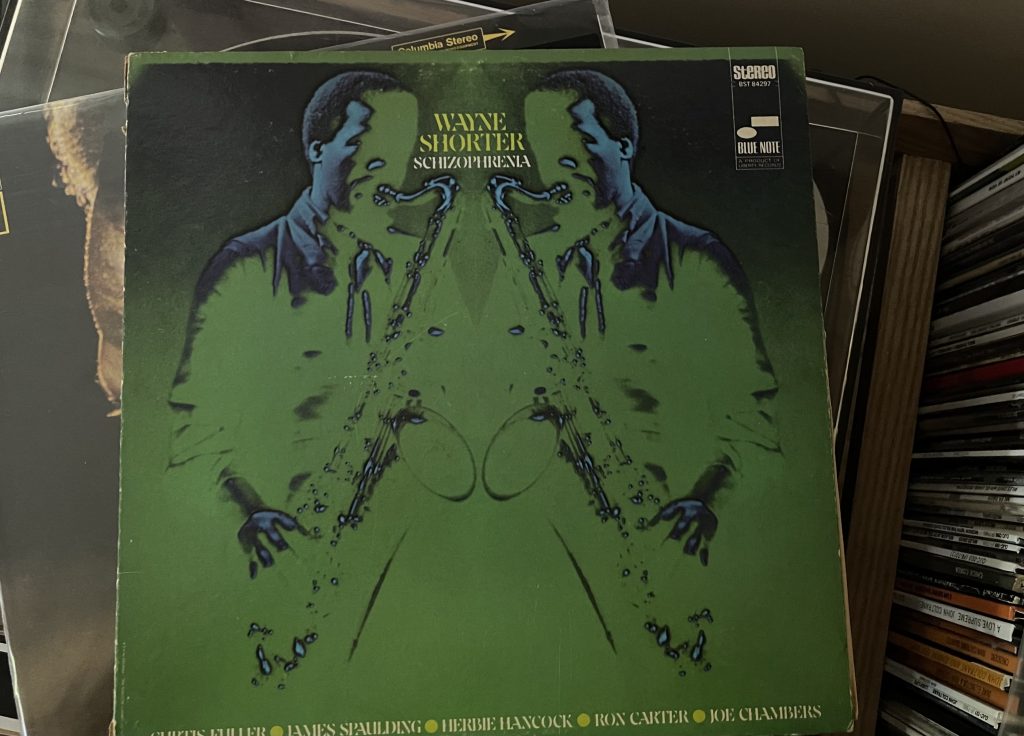
Album of the Week, July 16, 2022
Miles may have gone through some quieter periods between 1964 and 1966, but he and the quintet were now, it seems, determined to make up for lost time. We’ve entered a period of the discography where it’s difficult to cover the recordings in strict chronological order, between the albums that were all laid down in one session and the others that are made up of tracks from a variety of sessions, sometimes spanning several years. But before we commence the later part of the Second Great Quintet, there was still room for members of the group to record their own solo albums in between quintet sessions. And so we find Wayne Shorter on March 10, 1967, entering Van Gelder Studios once more for Blue Note, this time with a sextet: Curtis Fuller on trombone, James Spaulding on alto sax and flute, Herbie Hancock on piano, Ron Carter on bass, and Joe Chambers on drums, to record Schizophrenia.
The album gets off to a strong start, with a Shorter original we’ve heard before, now in a fuller arrangement. “Tom Thumb” here benefits from Herbie Hancock’s sambaesque introductory statement, as well as James Spaulding’s distinctive tone on alto and the remarkable timbre of Curtis Fuller’s trombone. Herbie’s solo, full of unusual chordal clusters and tones, is notable after all the right-hand-only solos we heard on Miles Smiles, just six months before; it’s a reminder of how much of a full orchestral sound he can bring to the party. James Spaulding’s solo on alto is striking as well, covering a range of two plus octaves and playing with the time before returning to the contours of the melody. After the rocky terrain of The All Seeing Eye, this is almost Wayne Shorter as pop artist, though there’s nothing watered down about those solos.
As if to remind us of the earlier album, “Go” opens with an out-of-time modal chord progression from the horns, but then enters a more wistful balladic feel as they settle into a gentle samba-influenced melody. The group plays freely with time through the intro, but you can always feel the pulse just below the surface. When Spaulding enters on flute, it’s breathtaking, as is the handoff from the diminuendo in the flute into Shorter’s tenor entrance. The concluding chorus opens with Shorter alone before the rest of the horns come in to provide melancholy counterpoint. It’s one of those remarkable Shorter compositions that sneaks under the blankets of your mind.
The title track, true to its name, seems to have a split psyche, opening in a slow out-of-time statement by the horns before kicking into a higher gear as a fast modal workout for the whole band. Shorter’s solo is appropriately fiery, of course, but we also hear Fuller on a blistering trombone solo and Spaulding seems to fan the flames.
“Kryptonite” is a James Spaulding composition, and features him on flute in the opening statement of the theme, alongside the rest of the horns, and then into a flute solo that starts with the opening chords and then finds its way into adjoining tonalities, all while holding onto the rhythmic drive of the theme. It’s a strong opening statement, and Shorter’s solo goes in a different direction, picking up a rhythmic figure from Spaulding and then making his own scale out of the raw material of the chords, before returning to the opening theme and his opening rhythmic statement. Hancock’s solo vamps over or two chords from the theme but is mostly a right-hand statement, before the final chorus comes in.
“Miyako,” named for Shorter’s daughter with his ex-wife Teruko Nakagami (who appears on the cover of Speak No Evil), is a ballad in the spirit of “Infant Eyes,” which was also dedicated to her. The melody is simple here, but the richness of the arrangement—where would this album be without Curtis Fuller’s trombone??—sets it apart, as does the chord progression that takes us from minor to relative major to lands unexplored in just a few bars. It’s stunning…
… but not quite as stunning as the opening of “Playground,” a full band workout that seems to flash from darkness to valediction to schoolyard namecalling in the first minute. We’re not in pop music territory here anymore, but the freer statement feels closer to where Shorter’s muse was taking him. Still, the closing is nowhere near as dark as The All Seeing Eye. Despite (or perhaps because of) the freedom of Shorter’s approach, we still find ourselves unexpectedly in a gospel moment as Hancock exchanges chords and comments under Fuller’s solo. Spaulding’s solo complements the gospel moment, but his repetition of the thematic idea is more free jazz than gospel shout. Hancock takes us back to the darkness from the opening theme, but playfully, with runs in the right hand against rumbled chords in the left, leading into the final chorus with the horns. A repeated blare on the final chord takes the song, and the album, out.
Schizophrenia is as wide reaching as its title suggests, finding Shorter revisiting some of the musical approaches from his earlier albums at the same time as he feels his way into new ways to approach free jazz. It’s a fun record, if measured by nothing else than it seems to end too soon. Some of the fun of the record would return in Shorter’s compositions on the next Miles Davis Quintet album; we’ll hear that next week.
You can listen to Schizophrenia here.

One thought on “Wayne Shorter, Schizophrenia”